List of commemorative plaques in Merseyside
Commemorative plaques in Merseyside, England, can be found across the region, highlighting notable people, buildings or historic sites. Many of the plaques are issued by authoritative bodies such as a council or a historical society that has a special interest.
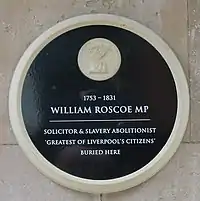
English Heritage
In the year 2000, London's blue plaque scheme was expanded to locations outside of the capital. In Liverpool, 14 English Heritage plaques were erected before the short-lived scheme ended.[1]
| Subject | Commemoration | Location | Inscription | Ref. | |
|---|---|---|---|---|---|
 |
Person | Bessie Braddock | 2 Zig Zag Road, L12 | Bessie Braddock 1899–1970
Labour politician and campaigner lived here 1945–1970 |
[1] |
.jpg.webp) |
Person | Charles Reilly | 171 Chatham Street, L7 | Sir Charles Herbert Reilly 1874–1948
Professor of Architecture lived here 1922–1925 |
[1] |
.jpg.webp) |
Person | Frank Hornby | The Hollies, Station Road, L31 | Frank Hornby 1863–1936
Toy Manufacturer lived here |
[1] |
 |
Person | Henry Tate | 42 Hamilton Street, Birkenhead | Sir Henry Tate 1819–1899
Sugar magnate and founder of the Tate Gallery traded here 1851–1861 |
[1] |
.jpg.webp) |
Person | John Brodie | 28 Ullet Road, L17 | John Brodie 1858–1934
City Engineer lived here |
[1] |
 |
Person | John Lennon | 251 Menlove Avenue, L25 | John Lennon 1940–1980
Musician and Songwriter lived here 1945-1963 |
[1] |
 |
Person | Joseph Mayer | Pennant House, Bebington, Wirral | Joseph Mayer 1803–1886
Antiquary and Collector lived here 1860–1886 |
[1] |
 |
Person | Noel Chavasse | 19 Abercromby Square, L3 | Captain Noel Chavasse V.C. And Bar 1884–1917
Royal Army Medical Corps hero lived here |
[1] |
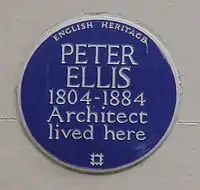 |
Person | Peter Ellis | 40 Falkner Square, L8 | Peter Ellis 1904-1884
Architect lived here |
[1] |
 |
Person | Patrick Abercrombie | 18 Village Road, Oxton, Birkenhead | Sir Patrick Abercrombie 1879–1957
Town and country planning pioneer lived here 1915–1935 |
[1] |
 |
Person | Ronald Ross | The Johnston Building, Quadrangle, L3 | Sir Ronald Ross 1857–1932
Discoverer of the mosquito transmission of malaria worked here |
[1] |
.jpg.webp) |
Person | Thomas Henry Ismay | 13 Beach Lawn, L22 | Thomas Henry Ismay 1837–1899
Founder of the White Star Line lived here |
[1] |
.JPG.webp) |
Person | Wilfred Owen | 7 Elm Grove, Birkenhead | Wilfred Owen 1893–1918
War Poet lived here 1900–1903 |
[1] |
 |
Person | William and Eleanor Rathbone | Greenbank House, Greenbank Lane, L18 | William Rathbone 1819–1902
And His Daughter Eleanor Rathbone 1872–1946 Politicians and Social reformers lived here |
[1] |
Liverpool City Council
Prior to 2005, a multitude of commemorative plaque of different colours could be found across Liverpool. Since then, some of these plaques have been replaced by Liverpool City Council with new black faced and stone-rimmed ones. Over 100 black plaques have been installed.[2]
| Subject | Commemoration | Location | Inscription | Ref. | |
|---|---|---|---|---|---|
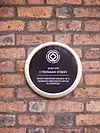 |
Building | 18th Century Liverpool Merchants House | 1 Trueman St | Built 1790 1 Trueman Street Finest Surviving Example Of A Georgian Merchants House In Liverpool | [2] |
 |
Person | Anthony Panizzi | Picton Library, William Brown Street | Lived And Taught Italian In Liverpool 1823–1828. Principal Liberian At The British Museum. Responsible For The British Museum Circular Reading Room On Which The Picton Library Is Modelled. | |
| Building | Bank Of British West Africa | West Africa House, 25 Water St (Standard Chartered Bank) | Built 1920 West Africa House Designed By Briggs,Wolstenholme & Thornely Former Bank Of British West Africa | ||
| Building | Castle Hey Chapel | Pearl Assurance House, Castle St / Harrington St | Registered Under Toleration Act 1689 Castle Hey Chapel From Whose Congregation Ullet Road Unitarian Church Was Founded Built Here | ||
 |
Building | Castle Moat House | Castle Moat House, Derby Square | Built 1838–1840 Castle Moat House Designed By Edward Corbett Former North & South Wales Bank | |
 |
Historic Site | Castle Street | 2 Castle Street, East elevation | Established C1240 Castle Street Lead To Liverpool Castle Demolished 1726 | |
 |
Historic Site | Castle Street | 55 Castle Street | Established C1240 Castle Street Lead To Liverpool Castle Demolished 1726 Now The Site Of Derby Square & Victoria Monument | |
| Historic Site | Chapel Street | Chapel Street (West End), St Nicholas Church Boundary Wall | Established C1257 Chapel Street Named After The Chapel St Mary Del Quay | ||
| Historic Site | Chapel Street | Chapel Street (East End), North elevation of Exchange Buildings | Established C1257 Chapel Street Named After The Chapel St Mary Del Quay Demolished 1814 | ||
| Person | Charles Booth | Liverpool University Sports Hall | 1840–1916 Charles Booth Ship Owner & Pioneer Of Social Research Born Here | ||
_plaque%252C_Basnett_Street%252C_Liverpool.jpg.webp) |
Person | Charles James Mathews | Marks and Spencers, Basnett St | 1803–1878 Charles James Mathews Actor, Theatre Manager & Playwright Born Here | |
| Building | Church Of Our Lady Of St Nicholas | St Nicholas Church doorway, Old Church Yard Off Chapel St | Founded C. 1360 Church Of Our Lady & St Nicholas Liverpool Parish Church Known Locally As The Sailors Church' | ||
 |
Building | Compton House | Marks and Spencer, Church St | Opened 1867 Compton House Designed By Thomas Haigh & Co One Of The Earliest Purpose Bilt Department Stores In Europe | |
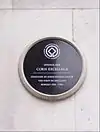 |
Building | Corn Exchange | Corn Exchange, Fenwick St | Opened 1808 Corn Exchange Designed By John Foster Junior The First In England Rebuilt 1953–1959 | |
.jpg.webp) |
Historic Site | Dale Street | 1 Dale Street (South elevation) | Established C1207 Dale Street Formally Dele (Dale) Street Here It Joined The Dell Through Which The Stream Ran Towards The Pool | |
| Historic Site | Dale Street | 139 Dale Street (South elevation) | Established C1207 Dale Street Formally Dele (Dale) Street Here It Joined The Dell Through Which The Stream Ran Towards The Pool | ||
| Building | First House in Rodney Street | 35 Rodney Street | Built C. 1783–1784 35 Rodney Street First House To Be Erected On Rodney Street On A Site Leased By William Roscoe | ||
| Person | George Stephenson | 34 Upper Parliament Street | 1781–1848 George Stephenson Chief Engineer Liverpool & Manchester Railway Lived Here | ||
| Person | Gerrard Manley Hopkins | St Francis Xavier, Salisbury Street | 1844–1889 Gerard Manley Hopkins S.J. Poet Served As A Priest 1879–1881 | ||
| Person | Goree Warehouses | 25 Beetham Plaza | Built 1793 Goree Warehouses Destroyed By Fire & Rebuilt In 1802 Damaged In Air Raid In 1941 Demolished 1948–1950 | ||
| Person | Hargreaves Building | Hargreaves Building, Chapel St | Built 1859 Hargreaves Building Designed By J.A.Picton For Sir William Brown | ||
| Person | Henry Booth | British Legion Club, 34 Rodney Street | 1789–1869 Henry Booth Founder & Director The Liverpool & Manchester Railway Company Born Here | ||
 |
Person | Herbert Louis, 1st Viscount Samuel | 11 Belvidere Road | Herbert, 1St Viscount Samuel Of Mount Carmel And Toxteth, (1870–1963) Statesman. Was Born Here. | |
 |
Historic Site | High Street | High Street (South end), West elevation of 1 Dale Street | Laid Out C1207 High Street Formally Joggler (Juggler) Street Site Of Weekly Market & Annual Fair Here Its Southern End Was Marked By The High Cross | |
| Historic Site | High Street | Chapel Street – Exchange Building (North elevation) | Laid Out C1207 High Street Formally Joggler (Juggler) Street Site Of Weekly Market & Annual Fair Here At Its Northern End Was Marked By The White Cross | ||
| Building | Hope Hall | Everyman Theatre, Hope St | Built C. 1837 Hope Hall Revivalist Preaching House 1853–1916 | ||
 |
Person | James Currie | George Henry Lee, Church Street | 1756–1805 Dr James Currie Humanitarian & First Biographer Of Robert Burns Lived Here | |
| Person | John Foster Junior | Notre Dame Convent, Mount Pleasant | C.1786–1846 John Foster Junior Architect & Corporation Surveyor Lived Here | ||
| Person | John Newton | Orleans House, Edmund St | 1725–1807 John Newton Abolitionist & Clergyman Author Of The Hymn 'Amazing Grace' Surveyor Of Tides 1754–1755 Lived Here | ||
| Person | John Newton | Orleans House, Edmund St | Built 1907 Orleans House Designed By Matear & Simon An Important Cotton Trading Centre | ||
_(cropped).jpg.webp) |
Person | Joseph Blanco White | Roscoe Memorial Gardens,Mount Pleasant | 1775–1841 Joseph Blanco White Spanish Writer & Political Exile Buried Near Here | |
| Lib.Jewish Synagogue | 1 Hope Place | ||||
 |
Building | Liverpool Medical Institution | Liverpool Medical Institution, Mount Pleasant | Founded 1836 Liverpool Medical Institution Designed By Clarke Rampling William Roscoe, Poet & Slavery Abolitionist Born Here 1753 | |
 |
Building | Lyceum | Lyceum, Bold Street | Lyceum Liverpool Library & Newsroom Designed By Thomas Harrison | |
| Building | Lyceum | Lyceum, Bold Street | Built 1800–1802 Lyceum Liverpool Library & Newsroom Designed By Thomas Harrison | ||
 |
Person | Lytton Strachey | 80 Rodney Street | 1880–1932 Lytton Strachey Biographer, Historian & Member Of The Bloomsbury Group Lived Here | |
| Building | Maltese Cross | Top Shop Store, Church St | 1704–1922 St Peter'S Church The Brass Cross Marks The Site Of An Entrance To The Anglican Pro Cathedral | ||
| Person | Matthew Arnold | Alfred Stocks Court, Turner Close | 1822–1888 Matthew Arnold English Critic & Poet Died Nearby | ||
| Building | Mechanics Institution | Liverpool Institute Mount Street | 1835–1837 Liverpool Mechanics Institution Designed By A.H. Holme Charles Dickens Gave Readings Here | ||
| Building | Metropolitan Cathedral Crypt | Cathedral Crypt | Opened 1958 Metropolitan Cathedral Crypt Designed By Sir Edwin Lutyens O.M. 1869–1944 Foundation Stone Laid 1933 | ||
| Building | Oceanic Steam Co. & White Star Building | Albion House, 30 James St | Built 1896–1898 Albion House Designed By Richard Norman Shaw White Star Line Offices | ||
| Building | Oceanic Steam Co. & White Star Building | Albion House, 30 James St | Founded 1869 The Oceanic Navigation Steam Company Founded By T.H. Ismay | ||
 |
Building | Octagon Chapel | 3 Temple Court (Between Victoria St & Mathew St) | 1763–1776 Octagonal Chapel Designed By Joseph Finney Later St Catherine'S Church 1776–1820 Built Here | |
| Historic Site | Old Hall Street | Daily Post & Echo Building, Old Hall Street | Established C1207 Old Hall Street Formerly Milne (Mill) Street Moore Hall Was Built In The C13 But Known As Old Hall After The Moore Family Moved To Bank Hall, Kirkdale In The C14 Old Hall Demolished C1820 | ||
| Historic Site | Old Hall Street | 1–9 Old Hall Street | Established C1207 Old Hall Street Formerly Milne (Mill) Street Moore Hall Was Built In The C13 But Known As Old Hall After The Moore Family Moved To Bank Hall, Kirkdale In The C14 Old Hall Demolished C1820 | ||
 |
Person | Peter Litherland | Lewis's Store, Renshaw Street | 1756–1804 Peter Litherland Revised & Patented The Rack Lever Escapement Watch Workshop Built Here | |
| Building | Philharmonic Dining Rooms | Hope Street | Built 1898–1900 Philharmonic Hotel Designed By Walter Thomas Decorative Work By Liverpool University School Of Applied Art Gates By H. Bloomfield Bare | ||
| Building | Philharmonic Hall | Philharmonic Hall, Hope Street | Built 1939 Philharmonic Hall Designed By Herbert J. Rowse Built On Site Of Philharmonic Hall 1846–1849 Designed By J. Cunningham Destroyed By Fire 1933 | ||
| Building | Prudential Assurance Building | Prudential Assurance, Dale St | Built 1885–1886 Prudential Assurance Building Designed By Alfred Waterhouse | ||
| Building | Queen Insurance Building | 8–12 Dale St | Built 1837–1839 Queen Insurance Building Designed By Samuel Rowland For The Royal Bank | ||
| Building | Royal Insurance Building | Royal Insurance, 1 North John St | Built 1896–1903 National Headquarters Royal Insurance Building Designed By James F. Doyle Very Early Use Of Steel Framed Construction | ||
| Building | Saracen's Head | Municipal Buildings, Dale Street | 1810–1853 Saracen'S Head Liverpool'S Most Famous Coaching Inn Built Here | ||
| Building | School for the Blind | Former Police Station, Hardman Street | Built 1850–1851 Liverpool School For The Blind Designed By A.H. Holme First School Of Its Kind In Britain, Founded 1791[3] | ||
| Building | School Of Art | Art College, Hope Street | Founded 1910 Liverpool School Of Art Designed By Willink & Thicknesse Mount Street Front 1882–1883 By Thomas Cook | ||
| Building | Sir Banestre Tarleton | 9-11 Fenwick Street | 1754–1833 Sir Banestre Tarleton Mp Major General Born Here | ||
| Building | Site −1st India Bldgs & Bldgs Architect | India Buildings, Water Street | Built 1923–1937 India Buildings Designed By A.Thornely & H.J. Rowse Home Of The Alfred Holt & Co Shipping Line The Site Of The First India Buildings Built 1837–1839 | ||
 |
Building | St Luke's Church & Gardens | St Luke's Church, Berry St / Leece St | Built 1811–1831 St Lukes Church & Gardens Designed By John Foster Senior & John Foster Junior Struck By Enemy Fire May 1941 Remains As Memorial To Those Who Died | |
| Building | St Mary Del Quay | St Nicholas’ Church, St Georges Dock Gates | C. 1257–1565 St Mary Del Quay Ancient Chapel Demolished 1814 Built Here | ||
| Building | St Phillips Church | Hardman House formerly Atlantic House, Hardman Street | Built 1816 St Philip'S Church Erected By John Cragg From Designs By Thomas Rickman Closed 1882 | ||
| Historic Site | Synagogue Court | MetQuarter, Victoria Street | Built By Joseph Clegg Mayor Of Liverpool 1748 Synagogue Court Here Stood Liverpool'S First Synagogue & Burial Ground C1750 "Let Them Make For Me A Sanctuary And I Will Dwell Among Them" Exodus 25:8 | ||
| Historic Site | Theatre Royal | Corn Exchange, Drury Lane | Built 1750 The Theatre Renamed The Theatre Royal 1771 Demolished C. 1828 Built Here | ||
| Person | Thomas Creevey | School Lane | 1768–1838 Thomas Creevey Mp & Diarist Born Here | ||
| Person | Thurston Holland | 43 Rodney Street | 1863–1941 Mr Thurson Holland C.H.M. F.R.C.S. L.L.D. Pioneer Of Radiology Worked & Lived Here | ||
| Historic Site | Tithebarn Street | 59/61 Tithebarn Street (Beetham House, south elevation) | Tithebarn Street Established As Moor Street C1270 Renamed In C16 When Molyneux Family Built A Barn Here To House Tithes Of Parish Of Walton | ||
| Historic Site | Tithebarn Street | 1 Tithebarn Street (Tithebarn House, south elevation) | Tithebarn Street Established As Moor Street C1270 Renamed In C16 When Molyneux Family Built A Barn Here To House Tithes Of Parish Of Walton | ||
 |
Building | Tower Building | Tower Building, Water St | Built 1908 Tower Building Designed By W. Aubrey Thomas Site Of Tower C. 1406 Fortified By Sir John Stanley | |
| Building | Turner Home (Lodge) | Turner home, Dingle Lane | 1882–1885 Turner Nursing Home Designed By Alfred Waterhouse In Memory Of Charles Turner Mp | ||
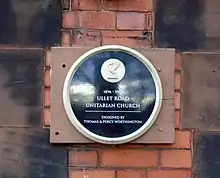 |
Building | Unitarian Church | Ullet Road | 1896–1902 Ullet Road Unitarian Church Designed By Thomas Percy Worthington | |
| Historic Site | Water Street | 22 Water Street (West End), South elevation of Tower Buildings | Established C1207 Water Street Formally Bonk (Bank) Street Here Its Western End Joined The Bank Of The River Mersey | ||
| Historic Site | Water Street | 1 Water Street (East End), North elevation of 2 Castle Street | Established C1207 Water Street Formally Bonk (Bank) Street Lead To The Original Bank Of The River Mersey | ||
 |
Building | Wellington Rooms | 127 Mount Pleasant | Built 1815–1816 Wellington Rooms Designed By Edmund Aikin Formerly Assembly Rooms | |
| Person | William Ewart | Roe St / Hood St | 1798–1869 William Ewart Mp Pioneer Of Public Libraries Born Nearby | ||
| Person | William Roscoe | Liverpool Medical Institution, Mount Pleasant | Solicitor & Slavery Abolitionist Greatest Of Liverpool'S Citizens' Buried Here | ||
 |
Person | William Roscoe | Roscoe Memorial Gardens, Mount Pleasant | 1753–1831 William Roscoe Mp Solicitor & Slavery Abolitionist Greatest Of Liverpool'S Citizens' Buried Here | |
| Building | Wykes Court | 111 Dale Street, Law Courts | 1720–1787 Wykes Court John Wyke Watch Maker Worked & Lived Here |
The Wavertree Society
Centred around Wavertree, Liverpool, local conservation group The Wavertree Society aims to preserve the area's architectural heritage and has issued its on series of green plaques. Its first three plaque were installed on 9 March 2012 and commemorated the Lock-up, the Monk's Well and Picton Clock Tower. The plaques themselves are manufactured a local firm Photocast Products Ltd, located in nearby Speke.
| Commemoration | Location | Inscription | Ref. | |
|---|---|---|---|---|
| Holy Trinity Church | Church Road, Liverpool | Designed by John Hope. Consecrated 1794 by the Rt Rev'd William Cleaver, Bishop of Chester. Altered and extended 1911 by Sir Charles Reilly. | [4] | |
.jpg.webp) |
No.102 High Street | High Street, Wavertree | Liverpool's only surviving example of a Georgian bow-windowed shopfront. | |
.jpg.webp) |
Picton Clock Tower | Childwall Road, Liverpool | Presented to the people of Wavertree in 1884 by Sir James Picton, architect, historian and politician, as a memorial to his wife Sarah Pooley. | [5] |
.jpg.webp) |
Royal School For The Blind | Church Road North, Liverpool | Founded in Liverpool in 1791, and moved here, to the site of Wavertree Hall in 1898. Legend has it that these gates will never be opened. | [4] |
.jpg.webp) |
The Blue Coat School | Church Road, Liverpool | Founded 1708 by Brian Blundell in School Lane, Liverpool. Moved here in 1906. Architects Briggs, Wolstenholme & Thornley. | [4] |
| The Coffee House | Church Road North, Liverpool | Probably Wavertree's oldest surviving public-house. In the 19th century it incorporated the Assembly Rooms and the Crown Brewery. | [4] | |
 |
The Lock-up | Childwall Road, Liverpool | Built in 1796 to house drunks and criminals overnight, it later accommodated cholera victims and refugees from the Irish Famine | [5] |
.jpg.webp) |
The Monk's Well | Mill Lane, Wavertree | Source of legend for many generations, The Latin rhyme means: 'He who here does nought bestow, the Devil laughs at him below' | [5] |
 |
The Smallest House | 93 High Street, Liverpool | Later part of the Cock & Bottle public house, No. 95 High Street was once known as the Smallest House in England. | [4] |
 |
Wavertree Garden Suburb Institute | Thingwall Road, Liverpool | Two 18th century farm cottages, converted 1912 to be the social, cultural and educational centre for the local community. | [4] |
 |
Wavertree Town Hall | 89 High Street in Wavertree | Headquarters of the Wavertree Local Board of Health, between 1872 and 1895. The Latin motto means: 'I flourish in the shade'. | [4] |
References
- "A history of blue plaques in the Liverpool City Region". Your Move. Retrieved 16 June 2017.
- "Blue plaque scheme". WhatDoTheyKnow. Retrieved 16 June 2017.
- "Open Plaques".
- "The Wavertree Society". openplaques.org. Retrieved 16 June 2017.
- "PLAQUES IN PLACE". The Wavertree Society. Retrieved 16 June 2017.